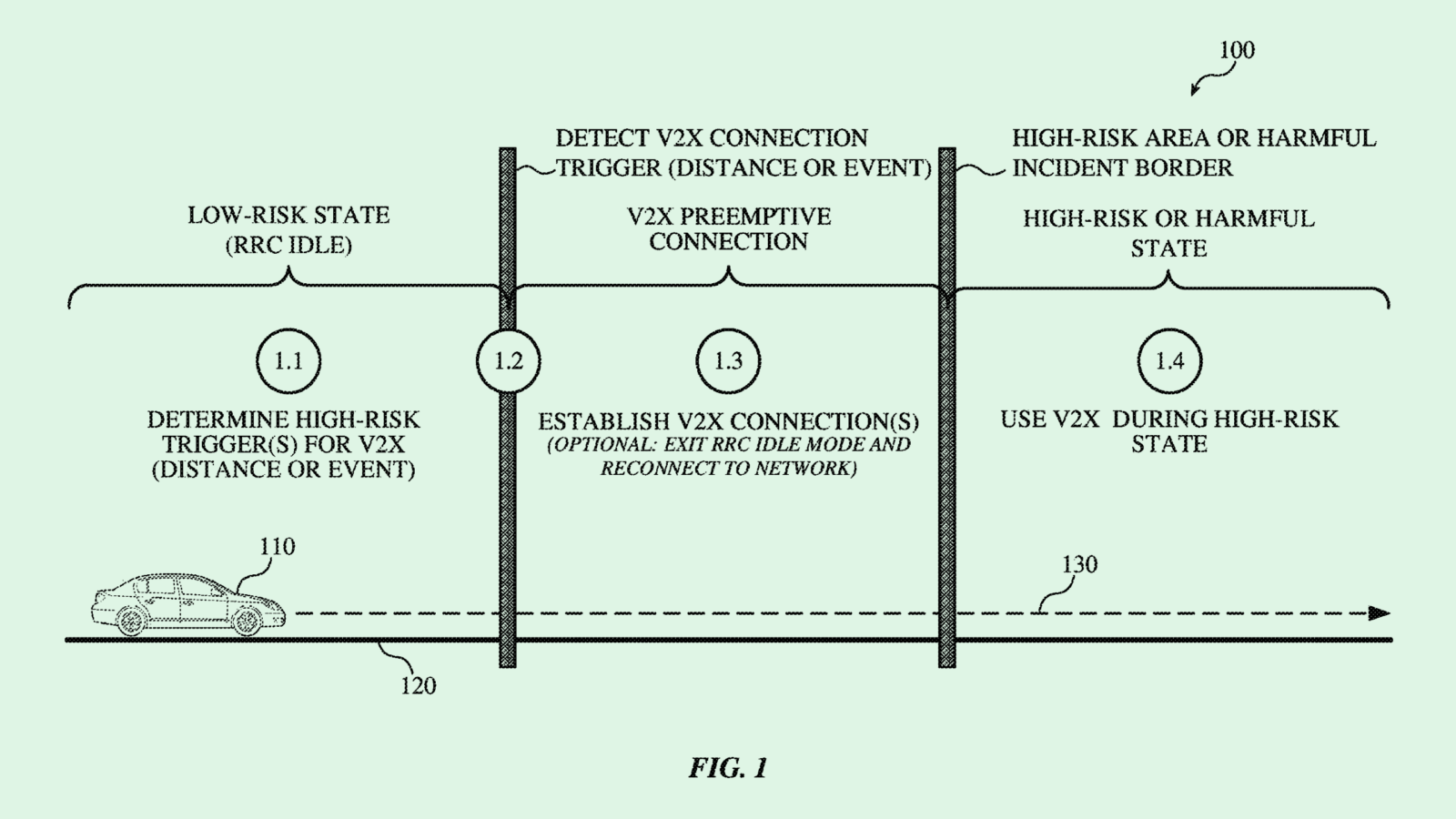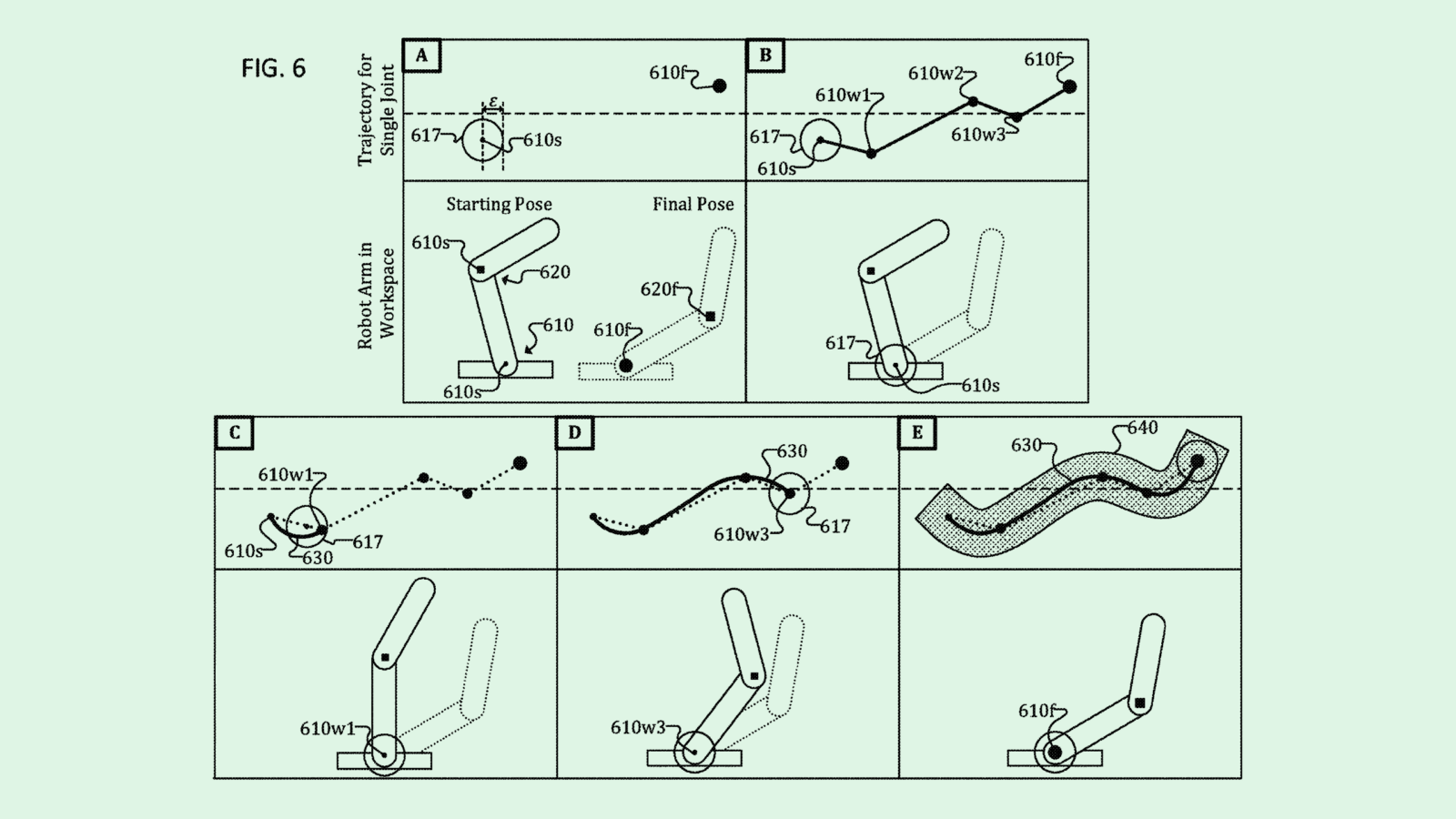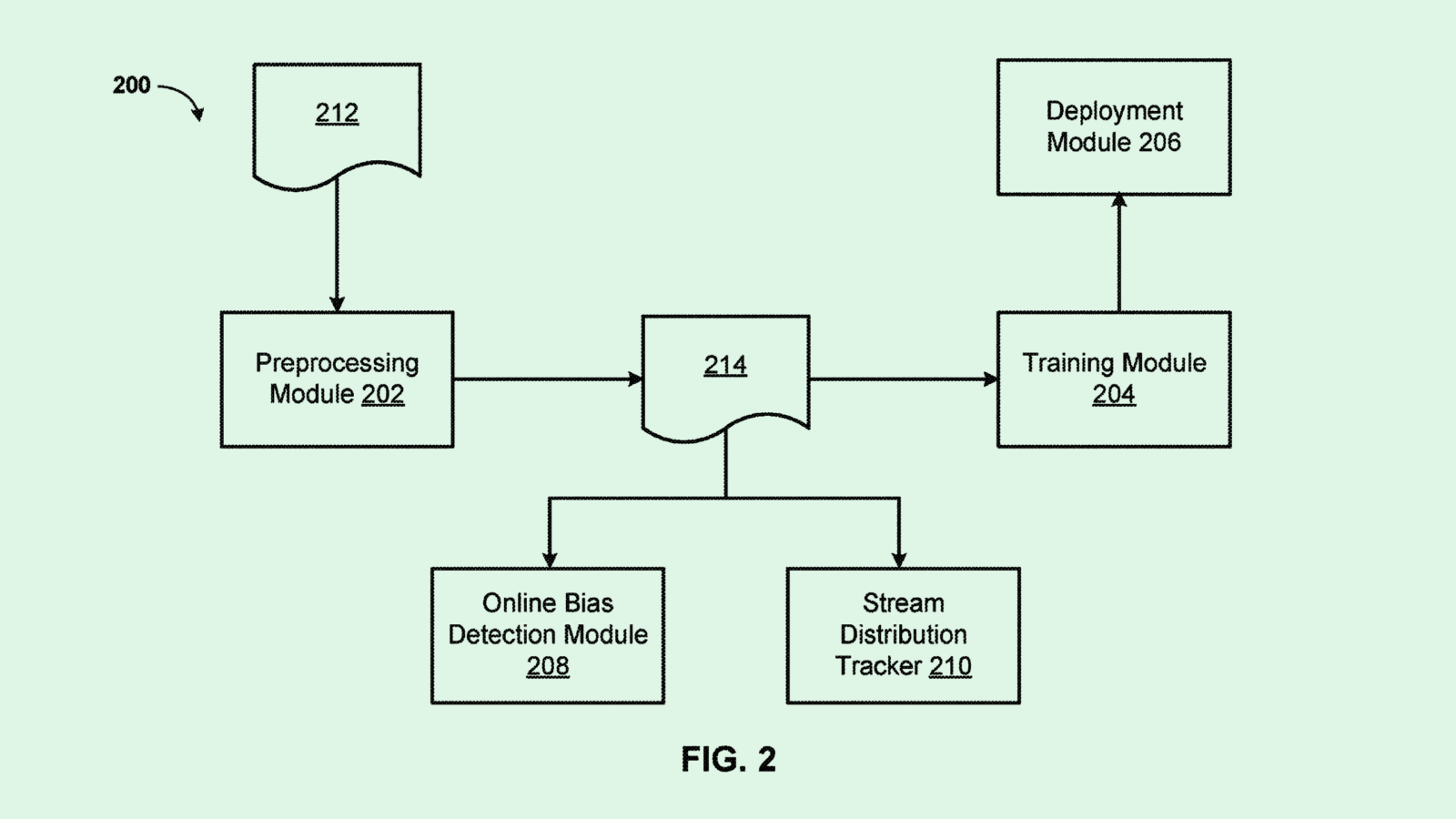Happy Monday and welcome to Patent Drop!
Today, an auto tech patent from Apple highlights that the iPhone maker has tons of vehicle-related intellectual property – and nowhere to use it. Plus: Intel clears a path for its factory robots; and IBM rids AI lending models of bias.
Let’s get into it.
Apple Handles Hazards
Even though an Apple-branded car will no longer hit the road, the company still wants to keep you from swerving.
The company is seeking to patent a “smart vehicle-to-everything” preemptive connection for emergency and potential accident scenarios. Apple’s tech aims to allow vehicles preemptively to connect directly with other vehicles or infrastructure before entering certain areas that may be deemed high risk or hazardous.
This connection would essentially allow vehicles and infrastructure to communicate with one another to mitigate risk. Establishing this connection before entering a high-risk area may help vehicles avoid threats or unsafe conditions.
“Currently available V2X connection techniques may be too slow to prevent or mitigate the risks of emergencies,” Apple noted in the filing. These techniques may cause a vehicle to remain non-connected prior to entering these areas, “and then beginning the transition to a V2X connected mode upon entering the high-risk area.”
This system monitors the car’s current route and location to determine if they’re about to enter a high-risk area, triggering a connection when one is within a certain distance. Apple noted that high-risk zones can include a hospital zone, school zone, high-traffic area or high pedestrian traffic zone. It may also establish this connection if it detects an “event initiative of an emergency” by the vehicle such as a sudden sharp turn, sudden acceleration or deceleration, or a collision. Apple’s tech makes these connections using communication standards (such as 5G) without the use of “traditional network infrastructure.”
In practice, this system may be able to warn a driver that the route they are on passes near an emergency situation, such as a fire or another driver’s collision. It may instruct the driver to modify their speed or route, engage in all-wheel drive, or pull their vehicle over based on this risk.

This patent became public days after news broke that Apple was winding down Project Titan, its project to build an autonomous and electric car, and shifting many of the 2,000 employees under its umbrella to the company’s AI division. However, in its years working on creating an Apple-branded vehicle, the company filed for hundreds of vehicle-related patents. The death of this division begs the question: What happens to all of that IP?
Some of it can be put to use in other parts of Apple’s business, said Micah Drayton, partner and chair of the technology practice group at Caldwell Intellectual Property Law. “There are a surprisingly large number of things that would be useful in cars, especially the AI side of things, that you might also find in a phone.”
This patent, for example, could be a part of Car Play, a standard which is already deployed in hundreds of different models of vehicles. However, things like a “user tracking” car seat headrest with spatial audio or a LIDAR system for precise depth mapping may be harder to reassign.
But just because the Apple Car is no more doesn’t mean the company will forget about its pile of patents. Even without being put to use, any of the company’s vehicle patents that were granted are quite valuable, said Drayton, and Apple has a few legal pathways it could cash in on that value.
For one, Apple could enforce the patents for this unused tech as they would have if an Apple car actually hit the road, he said, or enter its IP into a “patent pool,” he said, which licenses patents to third parties to deal with enforcement. Apple could also license its tech out to other companies itself, which would essentially make an agreement with automakers to not sue them when they otherwise could have. “What (granted patents) cover is not so much what you’re doing, but what you want other people not to do,” said Drayton.
It could also sell the patents themselves to other companies, including their rights to enforce them, he said. And if the company doesn’t want to get confrontational, it could put up these patents as collateral for a loan, Drayton said – which is an “underrated way of getting money out of your IP,” he noted.
And given that Apple has such a vast diversity of patents in this arena, Drayton said, the company could use a number of these options depending on the invention itself. But one thing is for sure: Even though its vehicle plans are dead in the water, all of Apple’s work can still certainly make the company a good deal of cash.
Intel’s Robot Router
Intel wants to make sure its robots don’t trip people up.
The tech firm is seeking to patent a “real-time motion and path planner” for robots. Intel’s patent details a system that helps autonomous robots move in accordance with their surroundings using sensor data and a building’s “occupancy information,” meaning who and what are around it.
“As the number of robots in such environments increases, so does the risk of hazardous interactions among robots and humans in shared spaces,” Intel noted in the filing. “Due to their size and cost … the processing and memory requirements for motion planning may be limited.”
Intel’s system plans around occupancy information in real time by calculating “occupancy probability” to determine whether the immediate space around the robot will be occupied or free. This uses a host of different sensors such as infrared cameras, depth and motion sensors, and LiDAR.
This occupancy information is then used to track a series of “collision-free waypoints” in between its starting state and its task goal using continuous scans of this sensor data. If the environment surrounding the robot becomes occupied, an “actions handler” within the system will re-plan the robot’s course of action.
Intel noted that this system may be put to use in structures such as a “manufacturing floor, an office building, (or) a warehouse,” such as a packaging robot in a shipping facility, a manufacturing robot in a factory, or a security robot in an office.
Conventional environmental monitoring and motion planning systems tend to map out the entirety of a space over a 3D grid, then plan out a robot’s trajectory from start to finish. However, in this case a robot may see too many spaces as being occupied, leading to it “overly restricting the movements of the robot.” By only monitoring the space directly around it, Intel’s system overcomes that issue, while also saving on computational resources.

Though Intel’s filing aims to improve the range of movement by robots in a factory setting, something that seems to be missing from this patent is what happens in the event of a collision, said Rhonda Dibachi, CEO of Manufacturing-as-a-Service platform HeyScottie. It’s safest for robots in manufacturing and logistics settings to have a “kill switch,” she said, because accidents can happen no matter how intelligent a machine is.
As it stands, there are strict regulations from the American National Standards Institute regarding how robots can be used in factory settings, Dibachi said, often limiting these machines’ capacity by keeping them fenced off from human interaction while in operation. But making these machines as safe as possible is a critical part of allowing them to coexist with human workers more efficiently, she said.
“To allow robots to integrate with humans is the next big thing,” said Dibachi. “If a worker has a robot buddy, they’re going to be much more effective. But if there’s any possibility that a robot is going to be able to harm somebody, it can’t coexist.”
While Intel’s patent references how this tech could be useful in collaboration with human occupants of a space, it also notes that this tech is “not limited to strictly human collaborations,” and could be applied to any “dynamic objects” it may share a space with. To that end, a patent like this could be helpful in bringing production closer to a lights-out model, in which there’s little to no human involvement.
And with 2.1 million unfulfilled manufacturing jobs expected 2030 according to the Manufacturing Institute, decreasing reliance on human labor may be a crucial stopgap to an impending labor shortage.
IBM Plays it Fair
IBM wants to level the lending playing field.
The tech firm filed a patent application for “online fairness monitoring in a dynamic environment.” IBM’s patent details a system to ensure that AI models in charge of making financial decisions are doing so without biases.
“AI models have been increasingly used to make sensitive decisions like money lending or visa approvals,” IBM noted. “Accordingly, there has been increased focus on ensuring that the deployed models are making fair decisions.”
IBM’s system essentially aims to decipher whether bias developed in a trained machine learning model based on continuous monitoring of how it treats certain “protected attributes.” Though IBM didn’t clarify how it defines protected attributes, in the context of bias in lending, this could be referencing factors like age, gender or race.
To determine if bias has developed, the system will test the reward probability for different attributes, meaning the likelihood of a positive outcome (such as approval for a loan or credit card) in the machine learning model’s decision. If the probability of a positive outcome falls below a certain threshold, the system notes that the model has developed bias against a protected attribute.
That reward probability threshold is determined by a “distribution of credit scores associated with one or more groups of the borrowers having a common attribute,” IBM noted. After detecting bias, the system will correct it by updating the distribution of credit scores to be more fair.
IBM’s system continuously updates this distribution and runs this bias check to determine if an AI model has developed biases over time by not evolving with new data. This monitoring overcomes situations where a machine learning model is fixed but the data is evolving, and “the model may become biased towards a particular group.”

Though IBM’s system targets finance specifically, it isn’t the first time we’ve seen tech firms tackle the issue of bias in their patent activity. Adobe has sought to patent a way to debias image translation models, and Sony and Intel have both sought to patent different ways to rid image datasets of social biases.
Biases in AI data can plant themselves models during training, and, if left unchecked, they can reproduce themselves and grow stronger over time. IBM’s system in particular targets this major potential issue with AI-based lending practices.
Though this bias may be unintentional, the financial consequences for this kind of discrimination can be extremely harmful. And financial institutions continuing to weave AI into their practices only makes the potential for bias even greater.
Regulators began to take notice of this issue last year as AI started to come into the public eye. The Consumer Financial Protection Bureau clarified in April that anti-discrimination laws apply to financial decisions made by AI tools. And in June, several government agencies proposed quality control standards for automated valuation models, which make financial decisions regarding real estate.
Federal Reserve vice chair of supervision Michael Barr noted at a conference in July that “while these technologies have enormous potential, they also carry risks of violating fair lending laws and perpetuating the very disparities that they have the potential to address.”
Extra Drops
- Apple wants to make sure your workout isn’t messing with your electronics. The company filed a patent application for devices with “sweat mitigation structures.”
- TikTok wants to be your DJ. The Chinese social media giant filed a patent application for a method for “music pushing” on its app to recommend songs.
- Ford wants to make sure you don’t lose traction. The automaker is seeking to patent a method for monitoring tire tread and recommending a tire rotation.
What Else is New?
- EU regulators hit Apple with a $1.95 billion antitrust fine, claiming it had a dominant position in the market of music streaming apps.
- AI startup Anthropic launched new models for Claude, its chatbot. The company said the new models are twice as likely to answer questions correctly.
- Alef Aeronautics, a SpaceX-backed startup that’s working on flying cars, says it has gotten 2,850 preorders for its vehicles.
Patent Drop is written by Nat Rubio-Licht. You can find them on Twitter @natrubio__.
Patent Drop is a publication of The Daily Upside. For any questions or comments, feel free to contact us at patentdrop@thedailyupside.com.
